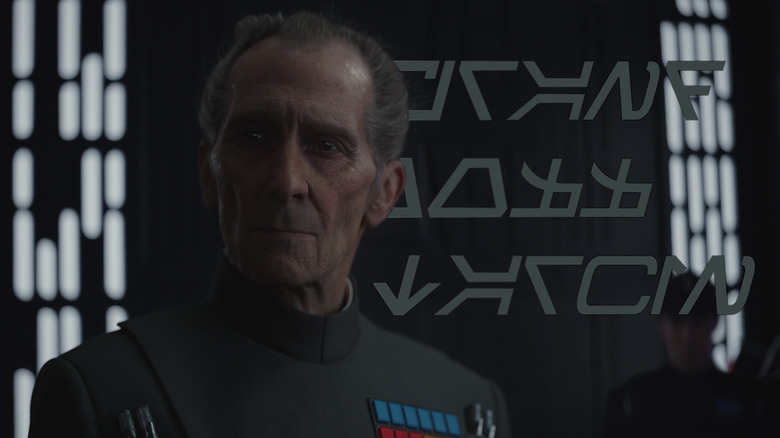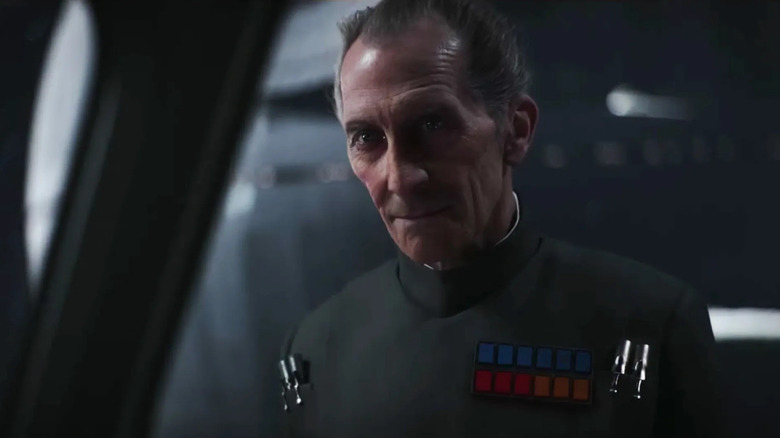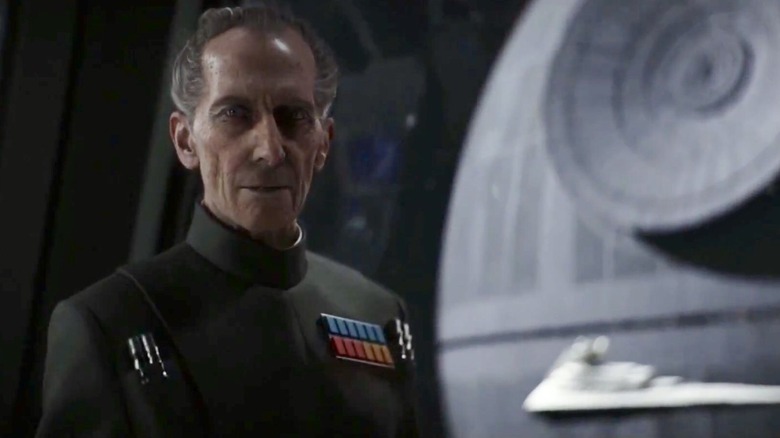A Subtle Peter Cushing Tic Threw A Wrench In Star Wars: Rogue One's VFX Double
Gareth Edwards' 2016 film "Rogue One: A Star Wars Story" was the first non-episodic feature from the "Star Wars" canon after Disney notoriously purchased Lucasfilm in 2012. At the time, Disney announced a very ambitious plan for "Star Wars" which involved releasing a new film every Christmas. The odd-numbered years would boast numbered chapters in the central "Star Wars" canon, and the even-numbered years would feature spin-off movies that take place at other points in the vast "Star Wars" timeline. That plan lasted only five years.
The plan likely fell apart through a lack of creativity. "Rogue One" was a direct prequel to the original 1977 "Star Wars," telling the story of how the Rebels secured the blueprints to the Death Star. This wasn't a broad expansion of the "Star Wars" myth as promised, but an inward turn. "Rogue One" was an announcement that "Star Wars" had no interest in straying from its tightly-constrained, central Skywalker myth, and that nostalgia imagery was going to take precedent on challenging new ideas.
Part of the nostalgia was the incorporation of several familiar "Star Wars" characters, some of them played by CGI versions of elderly or deceased actors. The central villain of "Rogue One" was Director Krennic (Ben Mendelsohn) who answered directly to Grand Moff Tarkin, the character played by Peter Cushing in the original "Star Wars." Because Cushing passed away in 1994, Tarkin appeared in "Rogue One" via some eerie motion-capture effects, pasting Cushing's scanned likeness over an on-set actor named Guy Henry.
In a 2019 interview with Vulture, "Rogue" special effects supervisor John Knoll revealed that Henry did a wonderful job, but that Cushing's lips — unique entities unto themselves — didn't move the same way. Recreating Cushing's mouth was a unique challenge unto itself.
Guy Henry
According to Knoll, having an actor on set was key to recreating Peter Cushing in CGI. At first, audiences saw Tarkin's face in reflection, leaving it unclear. This would have been a fine way to eschew the fact that the original actor was dead, but director Edwards wanted a whole face-to-face conversation between Krennic and Tarkin, requiring more elaborate effects.
Guy Henry has had an extensive acting career and began working in the early 1980s. He appeared as the title character in "Young Sherlock Holmes," and, immediately before "Rogue One," played Pius Thicknesse in "Harry Potter and the Deathly Hallows." It seems that Henry looked just enough like Peter Cushing that he would serve as an effective stand-in, and indeed could likely have played Grand Moff Tarkin without the aid of CGI. But CGI was the order, and that presented a new problem. Knoll recalls having a talk with Henry over his facial features, and Henry revealed that he could play a role, but wasn't able to do a straight-up impersonation. Knoll said:
"Peter Cushing had of course passed away years before, meaning this wasn't a situation where we had the subject available for consulting. So we found an actor to play the character on set. We'd replace his head or his whole body with our generated character afterward, but we wanted someone in the space, giving the other actors someone to play against. I think we did really well with Guy Henry. The one thing that he said up front was, 'I'm not a mimic. I can't do an impression. But what I can do is play the character with the same dignified, crisp speaking tone.'"
Which is fine. Until they realize that Cushing had an odd way of shaping "ah" sounds.
The dreaded 'ah' sound
Henry's facial features were captured using the same kind of head-mounted camera rig that was used in "Avatar." Knoll had already mapped out a full 3-D model of Cushing's face using footage from "Star Wars," which had good lighting and angles of the actor, and was going to "wrap" it around Henry's face. Henry, however, spoke in a certain way that didn't match Cushing's style. Cushing, it seems, would expose his teeth more often, demanding a more complicated rendering process. Knoll said:
"I was maybe too optimistic in the beginning, but we found that a great deal of likeness comes from the muscles of your cheeks and lips and mouth. When Peter Cushing made an 'ah' sound, he mostly moved his lower lip and exposed his lower row of teeth. Guy didn't really do that. When he said the lines that had that sound in the dialogue, it wouldn't look like Peter Cushing anymore. That was one of the big challenges, improving the likeness in little details like that."
Knoll knows all about the uncanny valley and was careful to avoid it. If the CGI model didn't look good enough, the eerie errors would be all an audience would be able to see. He continued:
"This kind of work is extremely sensitive, because there's always a point early on when it looks off-putting and terrible. It's not until you're about 98 or 99 percent done that it starts to look not-horrific. The uncanny valley is definitely a pitfall."
Whether or not Knoll was wholly successful can be debated; there is still an uncanny quality to the animated Cushing. Perhaps Henry's face might have been preferable in this instance.


